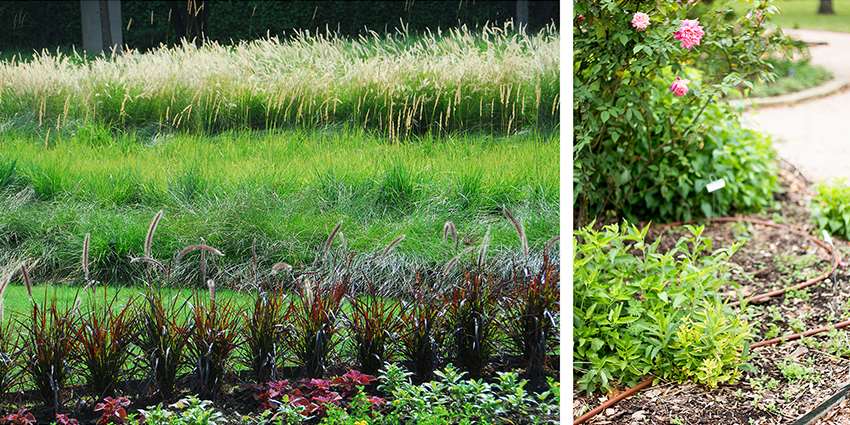Lawncare doesn’t just affect lawns — it can also impact the water quality in local watersheds. The Healthy Lawns and Healthy Waters (HLHW) program is helping residents better understand that connection to improve water quality and save time and money.
Now in its fourth year, this science-based community education program has seen positive results. Participants are adopting many of the management practices taught during workshops and reducing their use of nitrogen and phosphorus.
The HLHW program was started by the Department of Soil and Crop Sciences within Texas A&M AgriLife Extension Service and the Texas Water Resources Institute (TWRI) in 2017. Since its inception, the HLHW program has delivered science-based, community responsive education programing to 355 Texans at 13 events in five different watersheds, said Diane Boellstorff, Ph.D., associate professor in Texas A&M University’s Department of Soil and Crop Sciences and AgriLife Extension water resources specialist.
“We provide people with information to help them do the best that they can do in their own landscape,” Boellstorff said. “The program facilitates environmental stewardship for the home lawn.”
Lawns provide many services beyond aesthetics, said Becky Bowling, Ph.D., assistant professor in soil and crop sciences and Texas A&M AgriLife Extension specialist for urban water. Bowling also does work for TWRI and Water University.
Lawns control erosion, enhance groundwater recharge, dissipate heat and serve as biological filters. The choices that residents make in terms of their turf, soil and management practices affect how well lawns perform those services, she said, in turn affecting the watershed. Improper management can result in air and water pollution from fertilizers and pesticides, as well as wasted water.
The best lawn management practices vary with the local environment and needs, so the HLHW program curriculum is customized to each area. This customization starts, Bowling said, with choosing the right plants for the right places.
“Texas is extremely large and extremely diverse. One grass species may not be appropriate for every environment,” she said. “When you choose the right plant species for your area, you're going to minimize how many pesticides and fertilizers are required and how much water is required to maintain that plant.”
Efficient lawn irrigation is also key, she said. Ensuring efficiency starts with doing annual irrigation system audits.
“One of the things we really try to emphasize is staying engaged with your irrigation system throughout the season to ensure that it continues to work as efficiently as possible and doesn't waste water,” she said.
Learning about rainwater harvesting can encourage residents to engage with their irrigation systems, Boellstorff said.
“Rainwater harvesting can be a gateway to better irrigation methods and better knowledge of how to manage water on your property, because it’s intriguing to people,” she said. “And then once they have a rain tank, they might look at drip irrigation with the water from the rain tank instead of using the municipal water.”
Other best management practices are also vital, Bowling and Boellstorff said. Raising lawn mowing height encourages turfgrass rooting, while testing the soil can tell residents much about their lawns’ nutrient, pH and water needs. Free soil sample analysis is offered as part of HLHW workshops.
The HLHW program will be offering workshops throughout July, August and September. For more specific details on events and soil testing, see workshop event postings on the HLHW website.
Boellstorff said that by educating residents about specific, actionable lawncare and water use strategies, the HLHW program helps residents confidently improve their yards and protect their watersheds.
The HLHW program’s efforts are working, Bowling said. In six-month follow-up surveys, all HLHW participants said that they had applied at least some of what they learned at the training, and the majority were working on better watering techniques and fertilizing based on soil testing. Many participants also said they passed on the knowledge they learned.
Implementing those best management practices has had tangible results. Based on survey responses, the HLHW program estimated that the annual nitrogen applied to participants’ lawns was collectively reduced by approximately 19,000 to 114,000 pounds, depending on participants’ previous use. The phosphorus applied was collectively reduced by approximately 6,000 to 38,000 pounds.
Bowling said that means there’s also much less nitrogen and phosphorus entering the watersheds, helping to improve and protect water quality.
Using much less fertilizer — along with increasing water efficiency and using other best management practices — can save a lot of money, she said. The HLHW program estimated that participants have collectively saved approximately $7,200 to $45,000 per year by reducing fertilizer use alone.
“These best management practices give participants a landscape that’s more sustainable, both economically and environmentally,” she said.
The HLHW program is now going into its next phase, bringing its benefits to even more watersheds.
“There are so many impaired segments of streams in Texas, and urban areas are growing, so the number of yards is increasing in Texas,” Boellstorff said.
With more lawns comes more need for best lawn management practices, she said. The HLHW program, will continue teaching and empowering residents to better care for their lawns and watersheds.
“People like their yards. With the HLHW program, people know where to go to get information, so they won't make an expensive mistake down the road and regret it and then have to retrack,” she said. “It's nice to know who they can pick up the phone and call.”
Funding for the HLHW program is provided in part through Clean Water Act 319 grants from the U.S. Environmental Protection Agency through the Texas Commission on Environmental Quality.


